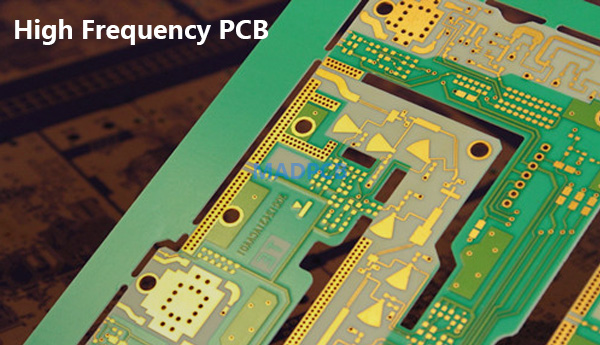
High Frequency PCB (Printed Circuit Board) refers to a type of circuit board designed to handle signals at higher frequencies, typically in the radio frequency (RF) and microwave range. These boards are specifically engineered to minimize signal loss, impedance mismatch, and electromagnetic interference, making them suitable for applications such as wireless communication, radar systems, high-speed data transfer, and other technologies where signal integrity is critical.

Here are some key differences between High Frequency PCBs and regular PCBs:
Material Selection: High Frequency PCBs often use specialized substrate materials with high dielectric constants and low loss tangents. Common materials include PTFE (Polytetrafluoroethylene) and FR-4 with specific modifications.
Thickness: High Frequency PCBs may have different thicknesses compared to regular PCBs to achieve controlled impedance and minimize signal losses. Thinner boards are often preferred for high-frequency applications.
Impedance Control: Maintaining a consistent and controlled impedance is crucial in High Frequency PCBs to ensure accurate signal transmission. This involves careful design of trace widths, spacing, and the dielectric material.
Transmission Line Design: The design of transmission lines, such as microstrips or striplines, is critical in High Frequency PCBs to minimize signal distortion and losses. These lines may be designed with specific widths and separations.
Signal Integrity: High Frequency PCBs focus on preserving signal integrity by minimizing reflections, crosstalk, and other signal distortions. This requires careful attention to the layout, routing, and grounding techniques.
Component Placement: The placement of components on a High Frequency PCB is strategic to minimize parasitic effects and maintain a clean signal path. Components may need to be positioned with precision to avoid interference.
Tolerances and Accuracy: High Frequency PCB fabrication processes often demand tighter tolerances and higher precision compared to regular PCBs. This is crucial for achieving the desired electrical characteristics.
Testing and Verification: High Frequency PCBs typically undergo rigorous testing and validation processes, including impedance measurements, signal integrity analysis, and often use specialized testing equipment to ensure their performance at high frequencies.
In summary, while regular PCBs are versatile and used in a wide range of electronic devices, High Frequency PCBs are specialized boards optimized for applications where the reliable transmission of high-frequency signals is paramount. They are designed with specific materials, geometries, and tolerances to meet the stringent requirements of high-frequency applications.